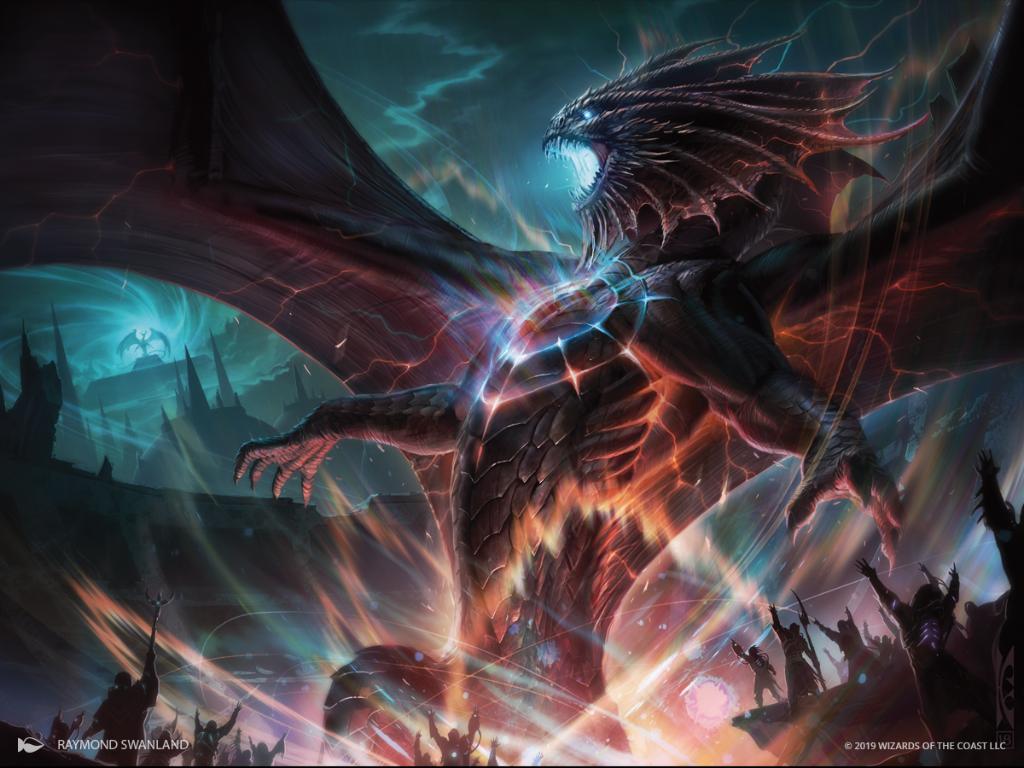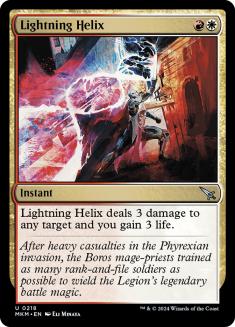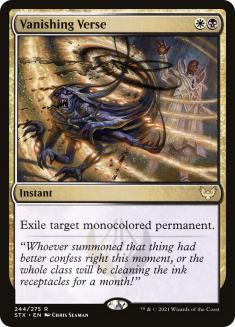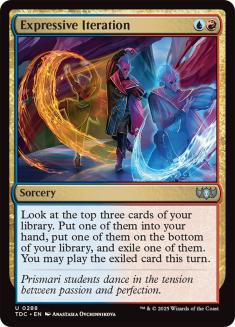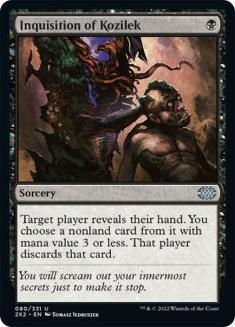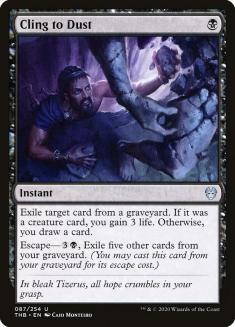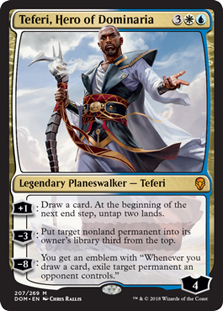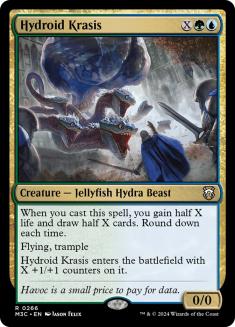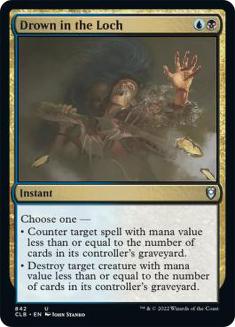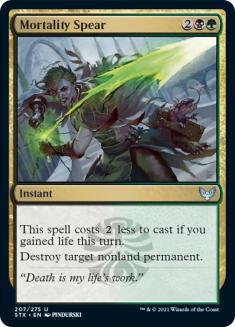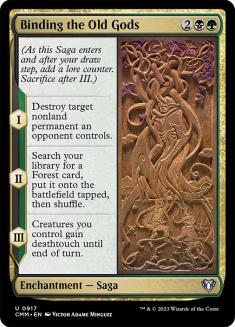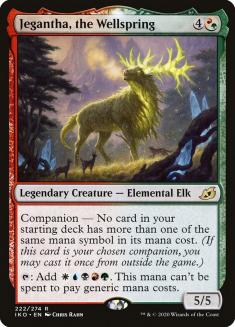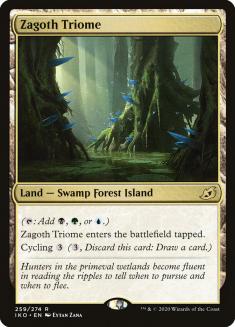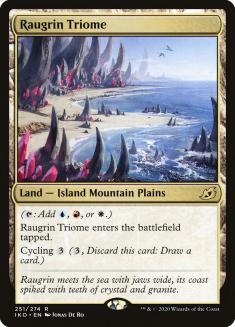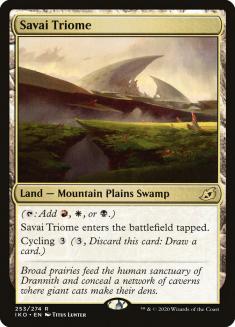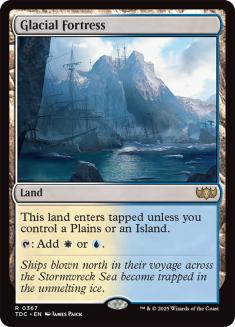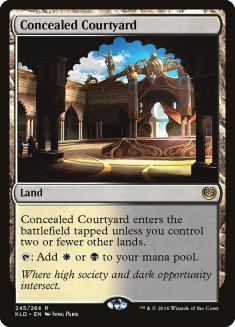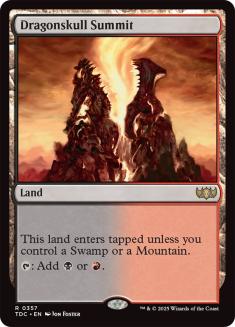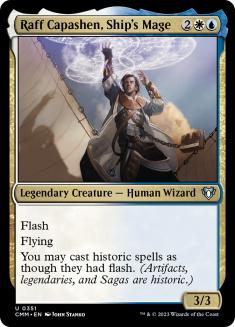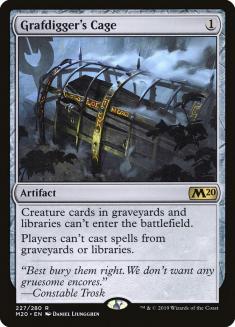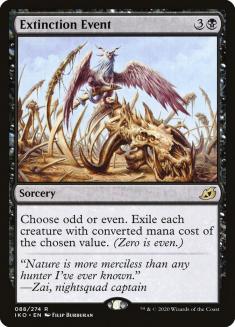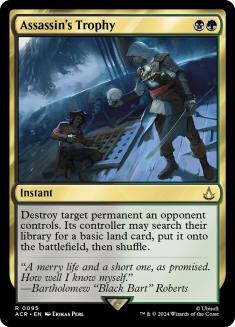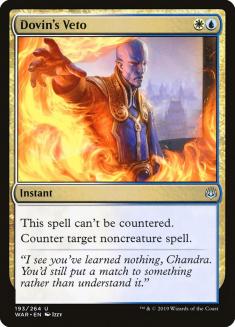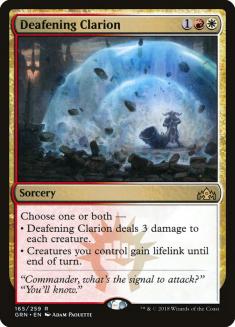For the Historic portion of the Strixhaven Championship I found myself registering Five-Colour Niv-Mizzet. This was a bit of a surprise to me, as a few days earlier I’d found myself sheepishly asking one of my teammates, “Would you humour me and let me test this against you for a bit?” I’d assumed all these decks I’d been beating on ladder would crush me in focused testing against a good player and that I could quickly move on and just register Izzet Phoenix or Orzhov Auras myself. But even in focused testing I just couldn’t stop winning, and importantly I became very confident that I was favoured against the aforementioned Izzet Phoenix with Niv-Mizzet. The showing for the deck was so convincing that both my teammates, who were skeptical at first, ended up jumping onto the deck themselves late into the testing process.
During the Historic rounds of the event, I was paired against Izzet Phoenix in all seven rounds, which is fairly absurd. One of those rounds I didn’t get to play due to internet outages, but in the other six I had a combined record of 12-1 in games; my thinking that this deck was able to crush Izzet Phoenix was proven true.
Creatures (5)
Planeswalkers (2)
Lands (27)
Spells (26)

It’s not that surprising that Niv-Mizzet Reborn would be good in Historic. Really it was only a matter of time; the card has been great in both Pioneer and Modern for a while, after all. The deck had been explored previously in Historic to middling success, but a few new multicolour cards can make all the difference, and it turns out we gained access to some great ones recently.
Stirxhaven brought a pair of amazing removal spells for the deck which really upped Five-Colour Niv-Mizzet’s ability to efficiently answer opposing threats. The lifegain offered by Lightning Helix is huge when you’re mainly trying to tread water until you can resolve the titular Dragon. Vanishing Verse exiles, which is great against a threat like Arclight Phoenix, whilst also offering an answer to scary enchantments and planeswalkers like Trail of Crumbs or Chandra, Torch of Defiance. Both these cards have weak spots, but they solve enough problems that they really help round out this deck’s arsenal. They’re even two-mana instants, which means they work fantastically alongside Teferi, Hero of Dominaria!
The real gain for the deck though was Expressive Iteration. I’m not sure I’ve played another deck in Historic that’s so good at taking advantage of that card. Your land count is high, meaning that if you want to use Iteration to hit your land drop you’re quite likely to hit; in this situation your 27-land deck is 84% to find at least one land, whereas Izzet Phoenix with its 21 lands is only 73% to find one.
Meanwhile, thanks to Thoughtseize and Inquisition of Kozilek, you also have a lot of efficient spells to cast off Iteration on Turn 3 as well; if you already have an untapped black source in hand, and you assume you’re happy to either hit your land drop with Iteration or find a discard spell for this turn, you’re now at 92% to get that full two cards of value. It’s very rare that Expressive Iteration doesn’t do a good Divination impression in this deck.
Even better than this, Iteration is also just structurally a helpful card to the deck. It digs deep looking for whatever colour of mana you’re missing, whilst also digging to find your Niv-Mizzet since you really want to resolve that card every single game; the fact that Niv-Mizzet can then grab you an Iteration, which in turn can dig you towards your next Dragon, means the card advantage often just won’t stop rolling in. Even better, in other decks taking two lands off an Iteration is often fine but unexciting, but here, not only are you looking to hit many, many land drops, but with eleven Triomes in your deck there’s a decent chance that you get to cycle one of those lands you take off Iteration as a rebuy.
The other big thing helping Five-Colour Niv-Mizzet is the discovery of how you want to build this Historic archetype. The thing is, you don’t actually need every Niv-Mizzet trigger to draw you four cards. Sure the times when you do the game will just be very over, but a 6/6 flyer that draws two good spells? That’s just a great card. Honestly there are times where your Niv-Mizzet can grab you a single spell and that will be good enough. This means you don’t need your deck to consist exclusively of multicolour cards and as a result you get to play Thoughtseize, one of the most powerful cards in Historic.
Adding Thoughtseize, Inquisition of Kozilek, and even Cling to Dust to the deck not only makes Expressive Iteration more consistent as mentioned earlier, it also does some interesting things in regards to how you want to build the deck overall. First, you get to have your manabase be very focused on making black mana to help enable early double-spell turns.
Second, you don’t really need to be playing mopey ramp spells like Coldsteel Heart that are bad topdecks; you’re so good at slowing your opponent down that it’s fine to just play your lands out one at a time and cast Niv-Mizzet Reborn on Turn 5, whilst ensuring that your topdecks are as good as possible in any ensuing topdeck war. You’re not quite playing a traditional Jund Midrange deck here, as there’s no real analogue to the early pressure presented by a Tarmogoyf or a Dark Confidant, but outside of that key difference the mentality really isn’t that different.
Teferi, Hero of Dominaria and Hydroid Krasis are both here for when you don’t draw Niv-Mizzet Reborn, or to help play around common answers to Niv-Mizzet such as Aether Gust. You’re going to need some form of over-the-top card advantage every single game, and these cards are fantastic at helping with that. Hydroid Krasis looks unexciting whenever it’s in your opening hand, but having the single copy in your deck to find in the late-game off a Niv-Mizzet trigger is just so powerful that it’s worth the occasional clunkiness in my experience.
Rounding out the set of answers the deck has access to, we have our Dimir and Golgari cards. Drown in the Loch can be awkward in the early-game, though discard spells help set it up and it’s just such an incredible card to find off a Niv-Mizzet trigger or hold up off a Teferi plus that I find it hard not to play the full four copies. Mortality Spear and Binding the Old Gods are good catch-all answers. I’m not really sure which is better, with Spear being instant speed and synergizing with Lightning Helix, whilst Binding offers a clean two-for-one and much-desired extra mana, but I have been content with a split of the two cards due to their different upsides and downsides.
It’s kind of amazing to me how good Jegantha, the Wellspring has been as this deck’s companion. You don’t cast it every game by any means, but having access to this 5/5 Elemental Elk at all times really helps make up for the deck’s relatively low threat density. In addition, the mana generation ability can be kind of absurd. If I suspect my opponent has a Mystical Dispute and I’m not under too much pressure, I’m quite happy to run out Jegantha on Turn 5 knowing that on Turn 6 the bonus mana that it provides, outright casting a Niv-Mizzet Reborn on its own, will make said Dispute look quite embarrassing. You also do occasionally get games where you struggle to find your fifth colour of mana, and in those games resolving a Jegantha is a surprisingly reasonable way to help it all come together.
Land sequencing in this deck is predictably a bit complicated. Three big things are going to be on your mind in the early-game. One is getting down a black source early so that you can resolve discard spells. The second is that you ideally want your first and second land to combine to be able to cast Expressive Iteration; this will be much more important if your hand is land-light since it’s more likely you’ll need to cast Iteration early to dig for lands, but is less important if you have a good mix of land drops and early interaction already and so won’t need to dig quite as soon.
The third thing, and the true ideal, is to figure out a pair of lands on the battlefield that can cast all three pieces of two-mana instant-speed interaction in your maindeck: Lightning Helix, Drown in the Loch, and Vanishing Verse. Finding a pairing that can do this makes it easier to hide what interaction you have open when passing the turn, whilst also allowing you to hold open multiple different options in the situation where you do have multiple options available.
This is important in general, but especially important to be able to recognise when it comes to Teferi, Hero of Dominaria’s plus ability untapping a pair of lands or when it comes to figuring out which lands to leave open on seven mana when resolving a Niv-Mizzet when you won’t even know what spells he’s going to grab. The complete list of pairings that can cast this trio of two-mana spells:
If you’re looking to improve the manabase, trying to make pairings like these come together more often would be a good place to start, but the cascading effects from trying to tinker with that sound kind of nightmarish and like you’d be just outright overhauling the manabase. I’ve been happy enough with the mana in the deck that I’ve not felt any need to do this personally.
I think the purpose of a lot of the sideboard cards is relatively intuitive, apart from Raff Capashen, Ship’s Mage. In testing we were finding Five-Colour Niv-Mizzet was pretty reasonable against the Magma Opus builds of Jeskai Control, and was quite good in Game 1 against the Kaheera builds of Jeskai Control. However, these Kaheera builds were causing a decent amount of trouble in sideboarded games; four copies of Shark Typhoon and a couple of copies of Commence the Endgame made the deck great at punishing you for not committing to the battlefield, but the increased density of countermagic in these sideboarded games made trying to resolve a Niv-Mizzet Reborn generally a losing battle too. All you had to do was resolve a Niv-Mizzet without being too far behind to become very likely to win the game, but it was just so hard to get to that point.
We tried everything but were not having much success. Extra discard spells in the form of sideboard copies of Duress could only do so much in the face of Brainstorm, whilst Allosaurus Shephard was helpful for letting Niv-Mizzet resolve but was a weak card on its own and still didn’t do anything against Aether Gust specifically. We decided to try Raff Capashen as a last-ditch effort and against all odds it was actually just…kind of perfect?
He’s a fine card to draw on his own, able to kill Narsets and pressure Teferis or keep baby Sharks at bay. When you draw him with Niv-Mizzet though, the card really shines. Now if your opponent wants to make a Shark or cast a Commence the Endgame in your end-step, you’ll get to flash in a Dragon whilst they’re tapped out. If they tap low for a Teferi, Hero of Dominaria, then this presents a similar opening for you to flash in a Dragon, especially if you have a Drown in the Loch or Dovin’s Veto as backup. The card is oddly game-warping at its best, and as someone who has always had a fondness for Raff it’s exciting that it finally has an admittedly somewhat niche home.
Sideboard Guide
VS Izzet Phoenix
Out:
In:
This is the baseline for how I like to sideboard against Izzet Phoenix, though the exact details vary a bit depending on their specific list. If my opponent has three or four Crackling Drakes, then I like to have a split of Thoughtseize and Inquisition of Kozilek, whereas if I see Niv-Mizzet, Parun in their sideboard or something similar, then I keep in all four Thoughtseizes and remove Inquisition entirely.
If I see multiple Brazen Borrowers in my opponent’s list and I really need room for other sideboard cards, then only bringing in one Grafdigger’s Cage is surprisingly reasonable, doubly so if my opponent happens to sideboard in Abrade as an answer to Cage, though I would never go without the full two copies against someone with Ox of Agonas. I’m much less likely to trim Teferi, Hero of Dominaria if my opponent has no copies of Negate or Spell Pierce but instead multiple copies of Aether Gust, since he’s then quite a bit easier to resolve. All these are fairly minor tweaks but good to be aware of.
I think this matchup is excellent for you, and one of the big draws to playing the deck; your removal just lines up very well against their threats, and 6/6 flyers are remarkably hard for your opponent’s deck to deal with. The big thing I’m looking for in opening hands is a way to deal with Sprite Dragon, as a Turn 2 copy of that card sticking around is the main way you can lose here, and I like to sequence my opening turns with that in mind.
When it comes to attacking with your Niv-Mizzet, it all comes down to how much you think the long-game favours you. If my hand is full of great cards, or I also have a Teferi active, I’m pretty disinclined to attack, as blocking a three-damage haster is much more likely to matter than pushing some damage; conversely, when all I have is my leading Dragon on the battlefield and a couple of removal spells in hand, it’s time to get aggressive since the long-game doesn’t necessarily favour you here, and with a couple of removal spells as backup, you’re set up well to race and close out the game quickly.
VS Jeskai Control
Out:
In;
Removal spells that don’t hit planeswalkers are bad actually. I think it can be fine to keep in a copy of Vanishing Verse if your opponent has a lot of copies of Commence the Endgame or even a Search for Azcanta, but in general I’m mainly just interested in fighting over resolving my Niv-Mizzets and preventing my opponent’s planeswalkers from taking over the game.
VS Jeskai Turns
Out:
In:
Grafdigger’s Cage doesn’t line up perfectly against Indomitable Creativity, but there are times where your opponent will target your Cage to get it off the battlefield and will give you a 6/6 flyer to block with as a result. Raff Capashen being in your deck makes this less consistent for you, but getting to play largely at instant speed is huge, as is using Raff to flash in Grafdigger’s Cage in response to the Creativity. Hydroid Krasis is already unexciting here as an expensive sorcery-speed card, but the fact that it’s such a bad hit off your opponent hitting Cage with Creativity makes me keen to sideboard it out.
Cling to Dust lines up very well against Mizzix’s Mastery and so I tend to hold back Cling with this in mind in the early-game. The matchup is certainly not easy, and is likely among the harder of the major matchups in Historic, but you certainly have the tools you need in order to win.
VS Jund Food
Out:
In:
There was some amount of disagreement on our team as to how to sideboard here. My teammates really dislike Inquisition of Kozilek since your opponent’s hand tends to empty quite quickly and their scariest card dodges Inquisition, whereas I think the discard is necessary to get Drown in the Loch online in time and for answering Witch’s Oven and Trail of Crumbs, which are both hard to remove without your opponent having already gained meaningful advantage from them. Grafdigger’s Cage is not a card I love against Jund Food, but being able to stop Woe Strider from escaping the graveyard is surprisingly relevant in order to keep Drown in the Loch active.
Your opponent’s scariest card is Korvold, Fae-Cursed King, and a lot of who wins will come down to how many copies of this card your opponent manages to resolve. If you can remove the first one immediately you’ll normally be fine, but the second copy resolving is close to unbeatable. Keep this in mind when selecting what to Thoughtseize, and be ready to try to turn the corner quickly once you’ve slowed down your opponent’s early-game.
VS Mono-Black Aggro
Out:
In:
I could see an argument for preferring Cling to Dust over Inquisition of Kozilek since your opponent’s creatures are so recursive, but I think there’s a lot of value in being able to strip away your opponent’s removal spell so that your Dragon can actually stick. A big part of the reason for the three copies of Deafening Clarion is that you have a decent shot at finding one from your Niv-Mizzet trigger, and giving him lifelink whilst clearing your opponent’s battlefield should be enough to push the game out of reach for your opponent.

